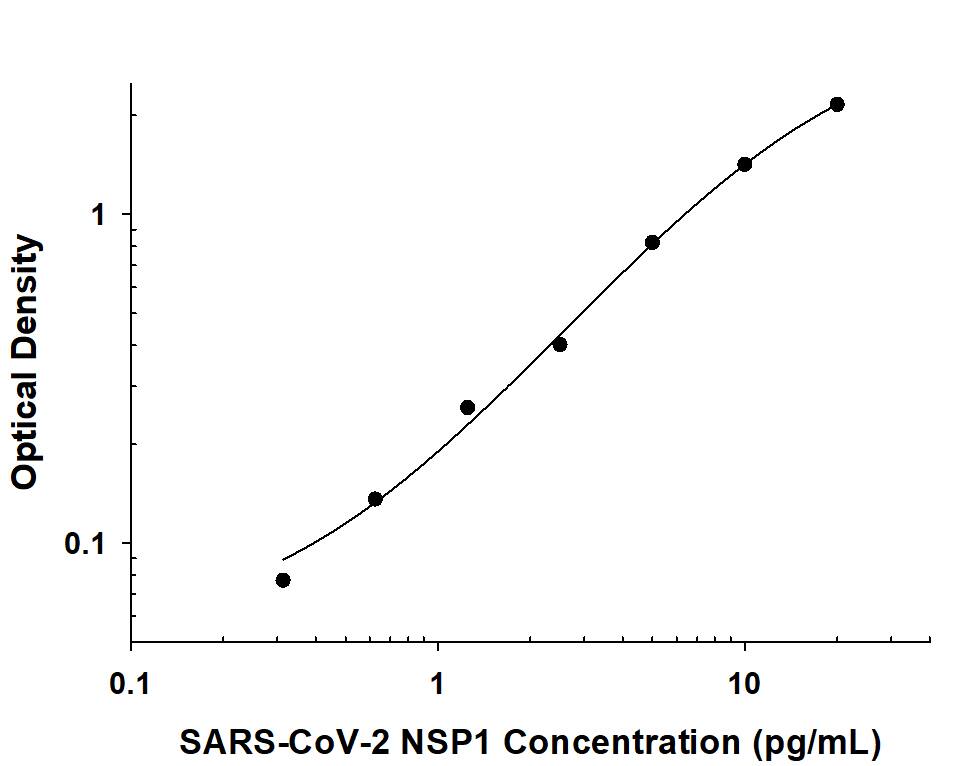SARS-CoV-2 NSP1 Antibody
R&D Systems, part of Bio-Techne | Catalog # MAB10991

Key Product Details
Species Reactivity
SARS-CoV-2
Applications
ELISA
Label
Unconjugated
Antibody Source
Monoclonal Mouse IgG1 Clone # 1045413
Product Specifications
Immunogen
E. coli-derived SARS-CoV-2 NSP1 protein
Met1-Gly180
Accession # YP_009725297.1
Met1-Gly180
Accession # YP_009725297.1
Specificity
Detects SARS-CoV-2 NSP1 in direct ELISAs.
Clonality
Monoclonal
Host
Mouse
Isotype
IgG1
Scientific Data Images for SARS-CoV-2 NSP1 Antibody
SARS-CoV-2 NSP1 ELISA Standard Curve.
Recombinant SARS-CoV-2 NSP1 protein was serially diluted 2-fold and captured by Mouse Anti-SARS-CoV-2 NSP1 Monoclonal Antibody (Catalog # MAB10980) coated on a Clear Polystyrene Microplate (Catalog # DY990). Mouse Anti-SARS-CoV-2 NSP1 Monoclonal Antibody (Catalog # MAB10991) was biotinylated and incubated with the protein captured on the plate. Detection of the standard curve was achieved by incubating Streptavidin-HRP (Catalog # DY998) followed by Substrate Solution (Catalog # DY999) and stopping the enzymatic reaction with Stop Solution (Catalog # DY994).Applications for SARS-CoV-2 NSP1 Antibody
Application
Recommended Usage
ELISA
This antibody functions as an ELISA detection antibody when paired with Mouse Anti-SARS-CoV-2 NSP1 Monoclonal Antibody (Catalog # MAB10980).
This product is intended for assay development on various assay platforms requiring antibody pairs.
Formulation, Preparation, and Storage
Purification
Protein A or G purified from cell culture supernatant
Reconstitution
Reconstitute at 0.5 mg/mL in sterile PBS. For liquid material, refer to CoA for concentration.
Formulation
Lyophilized from a 0.2 μm filtered solution in PBS with Trehalose. *Small pack size (SP) is supplied either lyophilized or as a 0.2 µm filtered solution in PBS.
Shipping
Lyophilized product is shipped at ambient temperature. Liquid small pack size (-SP) is shipped with polar packs. Upon receipt, store immediately at the temperature recommended below.
Stability & Storage
Use a manual defrost freezer and avoid repeated freeze-thaw cycles.
- 12 months from date of receipt, -20 to -70 °C as supplied.
- 1 month, 2 to 8 °C under sterile conditions after reconstitution.
- 6 months, -20 to -70 °C under sterile conditions after reconstitution.
Background: NSP1
References
- Snijder, E.J. et al. (2016) Adv. Virus Res 96:59.
- Thoms, M. et al. (2020) Science 369:1249.
- Schubert, K. et al. (2020) Nat. Struct. Mol. Biol. 27:959.
- Narayanan, K. et al. (2008) J. Virol. 82:4471.
- Jauregui, A.R. et al. (2013) PLoS One. 8:e62416.
- Kamitani, W. et al. (2006) Proc. Natl. Acad. Sci. USA 103:12885.
- Huang, C. et al. (2011) PLoS Pathog. 7:e1002433.
- Hartenian, E. et al. (2020) J. Biol. Chem. 295:12910.
- Zust, R. et al. (2007) PLoS Pathog. 3:e109.
- De Lima Menezes, G. and R.A. da Silva (2020) J. Biomol. Struct. Dyn. (In press).
Long Name
Non-Structural Protein 1
UniProt
Additional NSP1 Products
Product Documents for SARS-CoV-2 NSP1 Antibody
Product Specific Notices for SARS-CoV-2 NSP1 Antibody
For research use only
